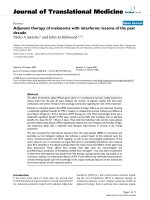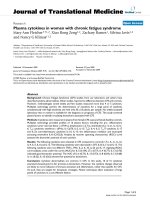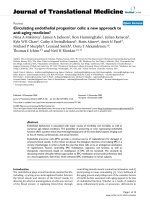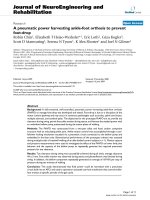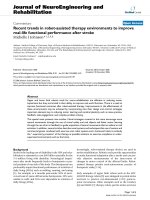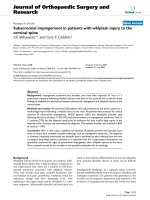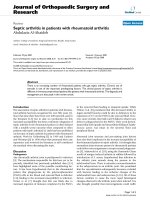báo cáo hóa học:" Subacromial impingement in patients with whiplash injury to the cervical spine" docx
Bạn đang xem bản rút gọn của tài liệu. Xem và tải ngay bản đầy đủ của tài liệu tại đây (199.29 KB, 4 trang )
BioMed Central
Page 1 of 4
(page number not for citation purposes)
Journal of Orthopaedic Surgery and
Research
Open Access
Research article
Subacromial impingement in patients with whiplash injury to the
cervical spine
Ali Abbassian*
1
and Grey E Giddins
2
Address:
1
Specialist Registrar in Trauma & Orthopaedics, North-West Thames Training programme, Mayday University Hospital, 530 London
Road, Croydon, CR7 7YE, UK and
2
Consultant Orthopaedic and Hand Surgeon, Hand to Elbow Clinic, 29A James street west, Bath, UK
Email: Ali Abbassian* - ; Grey E Giddins -
* Corresponding author
Abstract
Background: Impingement syndrome and shoulder pain have been reported to occur in a
proportion of patients following whiplash injuries to the neck. In this study we aim to examine these
findings to establish the association between subacromial impingement and whiplash injuries to the
cervical spine.
Methods and results: We examined 220 patients who had presented to the senior author for a
medico-legal report following a whiplash injury to the neck. All patients were assessed for clinical
evidence of subacromial impingement. 56/220 patients (26%) had developed shoulder pain
following the injury; of these, 11/220 (5%) had clinical evidence of impingement syndrome. Only 3/
11 patients (27%) had the diagnosis made prior to evaluation for their medico-legal report. In the
majority, other clinicians had overlooked the diagnosis. The seatbelt shoulder was involved in 83%
of cases (p < 0.03).
Conclusion: After a neck injury a significant proportion of patients present with shoulder pain,
some of whom have treatable shoulder pathology such as impingement syndrome. The diagnosis
is, however, frequently overlooked and shoulder pain is attributed to pain radiating from the neck
resulting in long delays before treatment. It is important that this is appreciated and patients are
specifically examined for signs of subacromial impingement after whiplash injuries to the neck.
Direct seatbelt trauma to the shoulder is one possible explanation for its aetiology.
Background
Whiplash injuries of the cervical spine are common. Addi-
tionally these injuries have a high incidence of legal action
and employment loss. There are a number of well docu-
mented symptoms associated with whiplash injuries.
These may include neck pain, occipital headaches, tho-
raco-lumbar back pain, parasthesia, weakness, visual dis-
turbances, vertigo and even dysphagia [1-4]. Pain
radiating to the upper limbs and/or shoulders is a com-
mon symptom. Additionally shoulder and neck pain can
often co-exist and the differentiation of cervical radiculitis
from primary shoulder disease at times can be difficult
[5].
Impingement syndrome, as a separate entity, however,
has less established links with neck injuries. Chauhan and
colleagues examined 524 patients who presented to the
Accident and Emergency department and reported a 9%
incidence of impingement type pain [6]. It has even been
Published: 27 June 2008
Journal of Orthopaedic Surgery and Research 2008, 3:25 doi:10.1186/1749-799X-3-25
Received: 21 January 2008
Accepted: 27 June 2008
This article is available from: />© 2008 Abbassian and Giddins; licensee BioMed Central Ltd.
This is an Open Access article distributed under the terms of the Creative Commons Attribution License ( />),
which permits unrestricted use, distribution, and reproduction in any medium, provided the original work is properly cited.
Journal of Orthopaedic Surgery and Research 2008, 3:25 />Page 2 of 4
(page number not for citation purposes)
suggested that subacromial impingement can present as
an asymptomatic variant and with neck pain alone [7].
In this paper we review the incidence of impingement syn-
drome in association with whiplash injuries in a group of
patients presenting for medicolegal claims and review the
relevant literature.
Patients and Methods
Individuals presenting to the senior author in a 10-year
period for a medico-legal report who had suffered a whip-
lash injury, were assessed prospectively for evidence of
subacromial impingement. Whiplash was considered
when the individual was complaining of pain and aching
to the neck in the presence or absence of restriction of
neck movements secondary to a hyper flexion/extension
injury caused by their recent accident. Those with neck or
shoulder symptoms prior to the index injury were
excluded from the study.
Anyone with shoulder pain was evaluated for clinical evi-
dence of impingement syndrome. This involved a full
examination of the neck and shoulder and assessing for
evidence of subacromial impingement. The diagnosis was
made on the basis of the following clinical tests: the Neer
impingement sign [8], Hawkins-Kennedy impingement
sign [9] the painful arc sign and supraspinatus muscle
strength test. Records were made of the details of any radi-
ological imaging that was performed before as well as
after the medicolegal report. When appropriate, radio-
graphs of the neck and shoulder had been taken to rule
out any bony injury. Further imaging (as part of the medi-
colegal assessment) was not, however, routinely obtained.
The inclusion criteria were therefore anyone with a new
onset shoulder pain following their neck injury as well as
having four positive clinical tests as described above.
If the injury was sustained in a Motor Vehicle Accident
(MVA) the position of the patient in the car, site of impact
and the use of headrests and seatbelts were documented.
Results
220 medico-legal reports were reviewed retrospectively.
Patients had been examined an average of 13.4 months
(range 1–59 months) following their accident. Male to
female ratio was 1:1.3 with an average age of 38 years
(range 10–83 years).
202/220 of the patients (92%) were involved in an MVA.
129/220 (64%) were as a result of rear impact. The
remaining 18 patients were riding motorbikes or bicycles,
or were pedestrians. 161/202 of the car accident victims
(80%) were drivers and 36/202 (18%) front seat passen-
gers. Only 3/202 (1.5%) individuals were not wearing a
seatbelt and 5/202 (2.5%) did not have a headrest in posi-
tion at the time of the accident.
Although none had an associated cervical spine fracture,
9/220 patients (4%) had sustained fractures of the limbs
or the skull. 133/220 patients (60%) had a concomitant
soft tissue injury to their thoracic or lumbar spine and had
complained of back pain after the incident. 21/220
patients (9.5%) had also sustained a minor head injury at
the time of the accident.
A total of 56/220 patients (26%) had shoulder pain fol-
lowing the injury, of these 11/220 (5%) had signs and
symptoms consistent with subacromial impingement
(Table 1). In the other 45 patients the symptoms were
radiation from the neck and no clinical or radiological evi-
dence of primary shoulder pathology was identified. All
11 patients with evidence of subacromial impingement
were involved in car accidents and 9/11 (81%) of them
were drivers. In one patient both shoulders were involved
and thus 12 shoulders with clinical evidence of impinge-
ment syndrome were identified. The seatbelt shoulder
Table 1: Patients with subacromial impingement following neck injuy
Patient Sex Age Side Position Pain first
noted
Seen by before
diagnosed
Diagnosed by Months to
diagnosis
Mode of
Diagnosis
1 F 68 Right Driver Day 1 GP, Physio Specialist 16 MRI/Clinical
2 M 60 Right Driver Day 2 GP Report 4 US/Clinical
3 M 60 Right Driver Day 7 GP, Physio Physio 20 Clinical
4 M 66 Left Driver Day 4 GP Report 5 Clinical
5 M 49 Right Driver Day 1 GP Report 6 US/Clinical
6 M 55 Right Driver Day 6 GP, Physio,
Chiropractor
Report 5 Clinical
7 M 47 Right Driver Day 2 GP Report 6 MRI/Clinical
8 F 69 Right Driver Day 4 GP, Physio Report 3 Clinical
9 M 84 Bilateral Driver Day 1 Inpatient, GP Specialist 3 MRI/Clinical
10 F 18 Left Front passenger Day 1 GP Report 5 US/Clinical
11 F 68 Left Front passenger Day 1 GP Report 1 Clinical
Journal of Orthopaedic Surgery and Research 2008, 3:25 />Page 3 of 4
(page number not for citation purposes)
(driver's right and front passengers' left – all were right
hand drive cars) was implicated in 10/12 shoulders (83%)
(X
2
, P = 0.021). In the 2 shoulders that the non-seatbelt
side was involved there had been documentation of direct
injury to the non-seatbelt side of the body in the patients'
medical notes at presentation. All of the patients had
noticed pain in their affected shoulder within the first
week after the injury and none had pre-existing shoulder
symptoms.
All patients had been seen by their general practitioner but
only one had been referred for specialist treatment. 3/11
(27%) patients had had their subacromial impingement
diagnosed prior to the medicolegal report (table 1). From
the three patients who were diagnosed prior to the report,
only one was diagnosed in the primary care sector, by a
physiotherapist who was delivering the 'neck' therapy.
The remainder had their diagnosis made at the time of our
report and subsequently advised to seek further medial
assessment. Mean time to diagnosis was 8.8 months
(range 2–20).
The group of patients who developed subacromial
impingement were on average older than the patients who
did not. 57.5 years verses 36.9 years (t-test, p = 0.002).
Discussion
The incidence of shoulder pain following soft-tissue inju-
ries to the neck is variable. In a prospective study of 93 car-
accident victims, 16 (18%) were found to have shoulder
symptoms at follow-up [10]. Others have quoted higher
figures but it is not clear what proportion, if any, had
impingement syndrome as a specific diagnosis. Chauhan
and colleagues examined 102 patients for evidence of
impingement syndrome [6]. The incidence of shoulder
pain was found to be 22% but only 9% had subacromial
impingement. Following soft tissue injuries to the neck up
to a third of the patients can be expected to develop shoul-
der pain. The incidence of subacromial impingement
however is less well established. In our series 26% of
patients had developed shoulder symptoms, which is
comparable to figures quoted above, but only 5% were
found to have clinical signs of impingement syndrome on
an average of 13 months after injury.
All our patients were involved in litigation and may there-
fore have different characteristics. It has been shown that
long-term disability following neck injury is unrelated to
the physical insult and those pursuing compensation have
the highest physical disability in terms of neck pain [11].
Although this has not been specifically validated for
impingement syndrome following neck injuries, a similar
outcome can be expected.
In our review of the literature we identified two other
studies that reported shoulder pain and subacromial
impingement following whiplash injuries to the neck
[6,12]. Gorski [7] described asymptomatic impingement
syndrome: where patients with neck pain alone
responded to subacromial injections with a complete or a
substantial relief of their neck pain. They postulated that
chronic neck pain can be caused by subacromial impinge-
ment which should be considered in the differential diag-
noses even if the shoulder is asymptomatic.
In our study clinical examination was the main tool for
diagnosing subacromial impingement although some of
our patients (table 1) did have radiological confirmation.
Clinical tests in combination have been shown to have
high post test probabilities for rotator cuff pathology [13].
Muddu et al [12] have suggested that the primary pathol-
ogy is due to a whiplash injury to the shoulder, as a sepa-
rate entity, rather than impingement syndrome. In their
series 15 out of 18 patients who were found to have
'shoulder symptoms' by a consultant orthopaedic surgeon
had no significant shoulder pathology on MRI. In fact
only 2 from 18 patients (11%) demonstrated rotator cuff
tears and evidence of subacromial impingement. It is not
clear however if their patients had positive clinical signs
for subacromial impingement (despite their negative
MRI) or they were merely complaining of generalised
shoulder pain following their neck injury.
Pain radiating from the neck to the shoulder after whip-
lash injuries is common and difficult to treat. In contrast
impingement syndrome can be helped with physiother-
apy, injection of corticosteroids and even surgery. It is
therefore important for clinicians to suspect and correctly
diagnose subacromial impingement in patients com-
plaining of shoulder pain following neck injuries instead
of merely blaming radicular neck pain as the cause. In fact
careful assessment can even identify and successfully treat
a group of patients who may present with 'asymptomatic
impingement' with pain outside the neck and at the
medial aspect of the scapula but not in the shoulder itself
[12].
In our series all the patients with subacromial impinge-
ment had consulted their family doctor but only 9% had
been referred to a specialist and less than a third had had
their diagnosis made prior to our medicolegal report.
None were diagnosed by their general practitioners. This
study highlights the fact that a potentially treatable condi-
tion in a small group of patients is diagnosed late or not
at all due to lack of awareness of the association between
neck injury and subacromial impingement.
The exact cause of impingement syndrome associated
with whiplash injuries is subject to debate. In our study
Publish with BioMed Central and every
scientist can read your work free of charge
"BioMed Central will be the most significant development for
disseminating the results of biomedical research in our lifetime."
Sir Paul Nurse, Cancer Research UK
Your research papers will be:
available free of charge to the entire biomedical community
peer reviewed and published immediately upon acceptance
cited in PubMed and archived on PubMed Central
yours — you keep the copyright
Submit your manuscript here:
/>BioMedcentral
Journal of Orthopaedic Surgery and Research 2008, 3:25 />Page 4 of 4
(page number not for citation purposes)
the seatbelt shoulder was involved in 83% of cases (X
2
, P
= 0.021) suggesting direct trauma from the seatbelt as a
possible cause. Moreover all 11 patients had developed
their symptoms early and between 1 and 7 days after the
injury further supporting direct trauma as an underlying
cause. Only two (17%) patients had symptoms in the
non-seatbelt shoulder. But even these patients were found
to have evidence of direct trauma to the non-seatbelt side
of their body. 'Patient 4' who was a driver with left subac-
romial impingement was noted to have 'bruising' around
the left elbow and forearm on the day of the accident.
'Patient 9' who was a driver with bilateral impingement
(left worse than right) also had severe bruising and ten-
derness on the left chest wall and axilla after the accident
and was admitted to hospital for analgesia and observa-
tion. In our study therefore, all of the shoulders that had
developed subacromial impingement had been subject to
direct trauma, by the seatbelt or otherwise.
The average age in the group of patients who developed
subacromial impingement was higher than those without
subacromial impingement: 57.5 years versus 36.9 years.
This difference is statistically significant (T-test, p =
0.002). This suggests that age or pre-existing degenerative
change leading to a decrease in the subacromial space may
be a risk factor for developing subacromial impingement
following direct trauma to the shoulder.
This study has several limitations. It is based on patients
in legal proceedings and may not truly reflect the general
population. The diagnosis of subacromial impingement
was made on clinical grounds only and although imaging
was available in a number of cases (table 1) it was not
used universally. Injection of local anaesthetic into the
subacromial space would have been a useful adjunct to
the assessment of the cohort.
Although a significant number of seat-belted shoulders
were identified, the numbers involved were small and a
larger study needs to be conducted to confidently link
seatbelt trauma to the development of impingement syn-
drome.
Conclusion
Recent studies have suggested an association between
whiplash injuries to the neck and shoulder pathology
[6,12]. It has even been suggested that impingement syn-
drome can present without shoulder symptoms and with
radicular neck pain alone [7]. This article is further valida-
tion that neck injury and impingement syndrome are
associated. The exact incidence is unclear, however the
diagnosis is commonly delayed due to lack of awareness
of the potential association between whiplash and subac-
romial impingement and the assumption that all shoul-
der symptoms emanate from the neck.
Following a neck injury therefore, patients who present
with pain outside the neck and radiating to the shoulder
should be carefully assessed for evidence of subacromial
impingement to avoid delay in the diagnosis of a poten-
tially treatable condition.
Authors' contributions
AA performed the data collection, the literature review
and wrote the manuscript, GEG performed the medico-
legal reporting, oversaw the data collection and helped in
manuscript preparation.
References
1. Schutt CH, Dohan FC: Neck injury to women in auto accidents.
A metropolitan plague. JAMA 206(12):2689-92. 1968 Dec 16;
2. Hohl M: Soft tissue neck injuries – a review. Rev Chir Orthop
Reparatrice Appar Mot 1990, 76(Suppl 1):15-25. Review.
3. Hohl M: Soft tissue injuries of the neck. Clin Orthop Relat Res
1975:42-9.
4. Balla JI: The late whiplash syndrome: a study of an illness in
Australia and Singapore. Culture, Medicine and Psychiatry 1982,
6(2):191-210.
5. Manifold SG, McCann PD: Cervical radiculitis and shoulder dis-
orders. Clin Orthop Relat Res 1999:105-13. Review.
6. Chauhan SK, Peckham T, Turner R: Impingement syndrome
associated with whiplash injury. J Bone Joint Surg Br 2003,
85(3):408-10.
7. Gorski JM, Schwartz LH: Shoulder impingement presenting as
neck pain. J Bone Joint Surg Am 2003, 85-A(4):635-8.
8. Neer CS, Welsh RP: The shoulder in sports. Orthop Clin North Am
1977, 8:151-63.
9. Hawkins RJ, Kennedy JC: Impingement syndrome in athletes.
Am J Sports Med 1980, 8(3):151-8.
10. Hildingsson C, Toolanen G: Outcome after soft-tissue injury of
the cervical spine. A prospective study of 93 car-accident vic-
tims. Acta Orthop Scand 1990, 61(4):357-9.
11. Joslin CC, Khan SN, Bannister GC: Long-term disability after
neck injury. A comparative study. J Bone Joint Surg Br 2004,
86(7):1032-4.
12. Muddu BN, Umaar R, Kim WY, Zenios M, Brett I, Sharma Y: Whip-
lash injury of the shoulder: is it a distinct clinical entity? Acta
Orthop Belg 2005, 71(4):385-7.
13. Park HB, Yokota A, Gill HS, El Rassi G, McFarland EG: Diagnostic
accuracy of clinical tests for the different degrees of subacro-
mial impingement syndrome.
J Bone Joint Surg Am 2005,
87(7):1446-55.
